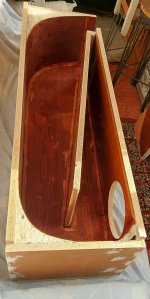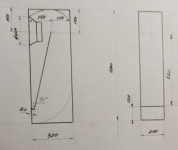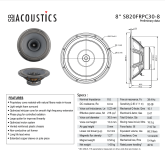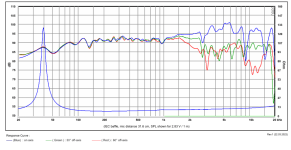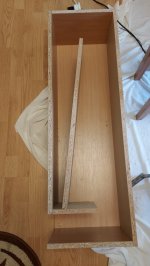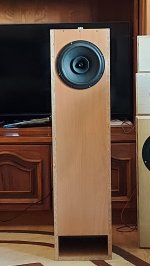Hello,I'm happy to spend my time doing my own speakers even if the result is unlikely to be very good.
For my age and my skill it must remain simple,verry simple.
I did after a public project with TBW8-1808 two TL enclonsure (VTP) using BG20 .
I like the gain obtained for the bass, the pleasant sound and the simplicity of the construction (without the complication of filters).
Now I ordered SB20FRPC30-8 and I want to repeat this project for another destination.
It can be the same but it can't be that easy ,to use any driver and expect good results.
Here your help can be welcome if it is possible.
That's only if you can tell me simply
" try to change these dimensions" "or tune the speaker by doing this"
It's a bit late to start studying acoustics, it only matters what I can get now .
Thank you.
For my age and my skill it must remain simple,verry simple.
I did after a public project with TBW8-1808 two TL enclonsure (VTP) using BG20 .
I like the gain obtained for the bass, the pleasant sound and the simplicity of the construction (without the complication of filters).
Now I ordered SB20FRPC30-8 and I want to repeat this project for another destination.
It can be the same but it can't be that easy ,to use any driver and expect good results.
Here your help can be welcome if it is possible.
That's only if you can tell me simply
" try to change these dimensions" "or tune the speaker by doing this"
It's a bit late to start studying acoustics, it only matters what I can get now .
Thank you.
Attachments
Ok,thank you, it's a good start and makes my work much easier.
What is missing is the size change required when changing the driver.
Except the price... BG20 it does not have such different T/S parameters compared to the original driver project TBW8-1808 .
SB20FRPC30-8 the same.
Ex : Sd 214 vs 220 vs 216 cm^2
What is missing is the size change required when changing the driver.
Except the price... BG20 it does not have such different T/S parameters compared to the original driver project TBW8-1808 .
SB20FRPC30-8 the same.
Ex : Sd 214 vs 220 vs 216 cm^2
Counterproductive actually as the corners act as crude acoustic HF filters.The roundness of the corner is unnecessary.
FWIW/YMMV, etc., for future reference this driver's specs indicates a MLTQWT/MLhorn is best overall TL choice.
AlexZB-thanks for the support.
GM-thank you ,those verbal abbreviations, I hope to get closer to their meaning .
On the topic indicated by you ,I especially noticed your post 23 ,37 and more.
There is a lot to read, and more , years of study and attempts.
Things like these can be helpful :
-for a good back loading of the driver, the height of the outlet mouth must be smaller with...
-or Sd driver requires increasing the cabinet section by (?2%?)
-etc
-and the roudings of the corner-i already know that
A good alternative would be DDVP-20, isn't it ?
GM-thank you ,those verbal abbreviations, I hope to get closer to their meaning .
On the topic indicated by you ,I especially noticed your post 23 ,37 and more.
There is a lot to read, and more , years of study and attempts.
Things like these can be helpful :
-for a good back loading of the driver, the height of the outlet mouth must be smaller with...
-or Sd driver requires increasing the cabinet section by (?2%?)
-etc
-and the roudings of the corner-i already know that
A good alternative would be DDVP-20, isn't it ?
The effect is very small.Counterproductive actually as the corners act as crude acoustic HF filters.
Roundings has the effect of stiffening the cabinet, adding mass (especially if filled with led shot or sand) and making it a wee bit more efficient (even if bass waves can’t see obstacles much smaller than their wavelength in open air, they are affected by them in constrained environments, like a tube).
But overall the time and energy is often much better spend elsewhere.
The square corners most important effect is not as filters but in spreading out the resonating bandwidth of the cavity. So in essence you trade a bit of efficiency for less “one note” resonance.
It can make sense to round the corners if you for example want a smaller design and/or you have a small, low compliance suspension driver.
Smaller height of the mouth gives more mass loading, resulting in lower tuning of the cabinet and better filtering of higher frequencies, but also lower efficiency.-for a good back loading of the driver, the height of the outlet mouth must be smaller with...
In modern designs crossection of the pipe is not directly related to Sd.-or Sd driver requires increasing the cabinet section by (?2%?)
If this cabinet works well with BG20 any driver with similar specs will be ok.
Thanks for the posts.
The rounding of the corners does not concern me too much.
Tests can be done with and without these.
I assume that the T/s parameters of the driver are important when designing the TL.
What would be the parameters that require special attention when replacing the original driver so that no dimensional changes are necessary ?
The rounding of the corners does not concern me too much.
Tests can be done with and without these.
I assume that the T/s parameters of the driver are important when designing the TL.
What would be the parameters that require special attention when replacing the original driver so that no dimensional changes are necessary ?
You're welcome!AlexZB-thanks for the support.
GM-thank you ,those verbal abbreviations, I hope to get closer to their meaning .
On the topic indicated by you ,I especially noticed your post 23 ,37 and more.
There is a lot to read, and more , years of study and attempts.
Things like these can be helpful :
-for a good back loading of the driver, the height of the outlet mouth must be smaller with...
-or Sd driver requires increasing the cabinet section by (?2%?)
-etc
-and the roudings of the corner-i already know that
A good alternative would be DDVP-20, isn't it ?
I've very little time to devote to the forums nowadays and maybe future as well, so best to search by subject matter for mine and others knowledge. ML-TQWT, etc., originated with Martin J. King's work from a purely technical POV, ergo is the 'Gospel' with mine being from experience and the very simple ROT's* that I derived from it, so in comparison mine are acoustically 'fat' whereas MJK's have no excess, so preferred for smallest footprint/folding.
Re height/width ratios, the pioneer's concluded that a 1.0:1.4142 ratio was the limit before it starts to impact airflow performance and 1.0:1.4142:2.0 ratio for a speaker box, so for high aspect ratio cabs the 2.0 gets increased at an acoustic ratio (math on the net and in some audio textbooks, but no time for searching for them).
?? You do what you got to do to fit the driver and maintain the desired cavity net Vb.
?? Dunno, ask the designer.
* I design a textbook BR alignment for the above acoustic ratio box and extend it to suit my desired driver/floor height with the driver at an odd pipe harmonic offset based on the needs of the app. Can't recall ever publishing this except piecemeal, though with try to make a compilation as time permits, though again, MJK's is most technically correct.
Sorry, I dont have a simple answer.I assume that the T/s parameters of the driver are important when designing the TL.
What would be the parameters that require special attention when replacing the original driver so that no dimensional changes are necessary ?
Modern designs are based on Vas, Fs and Qts. Just like closed and vented boxes.
Even if they are different, they can be in such relation to each other that two drivers needs a box of almost identical size and tuning.
Things are not that critical, 5-10% of tolerance wont make significant difference in performance, and fine tuning is achived by stuffing.
Theres also tolerances in drivers specs, effects of room acoustics and speaker placement etc.
So you really dont have to go for pin-point accuracy.
As GM said, work by M.J.King is the most recent. If you want some good guidelines, I recommend you the article "Classic Transmission Line Enclosure Alignments" from 2021.
But the best way to design such cabinet are modeling programs like
Hornresp.
...
A good alternative would be DDVP-20, isn't it ?
...
?? Dunno, ask the designer.
...
DDVP-20 seems to have been a fit at that time
https://www.diyaudio.com/community/...e-cheap-monster-ii.385062/page-3#post-7142366
And, FWIW, here's the YT link
I needed some courage to open this topic.
Thank you all for understanding, decency and kind answers.
I am also on another forum, but here you have only quality people.
Logically, it is not a good idea to build my own speakers.
But what should I do if that makes me happy .
I appreciate that some very busy people took their time to send me an answer.
If I miss something important from the answers received,
or I didn't understand well, please draw my attention.
GM-Thank you-on the internet I read about Voigt , TL ,...
Martin J King's website with a lot of math , the (golden )ratio ,etc
I'm not the lazy type .
I have some Gb of data,software,cabinet plans on my computer.
To build the speakers NOW all this does not help too much.
Grindstone-thank you,I know this information, I posted on that topic.
DDVP it is a great temptation .
Davor D-thank you for all direct answers to my questions.
"5-10% of tolerance wont make significant difference"
Very convenient for me and I will choose this, no other simple choice.
Even if Vas for TBW8-1808 is 88L and for SB20FRPC30-8 it is 66L- the difference is greater than 10% .
I assume that part of those 5-10% percentages can be solved in the tuning stage.
Optimization by arranging the absorbent material and
adjustment for driver protection so as not to exceed Xmax
(here we only have the possibility of adjusting the height of the exhaust mouth IF necessary)
One of you with great potential and measuring equipment
may be tempted to try this original TL model with rounded corners (practically not theoretically)
Then tell us how it sounds and of course the technical conclusions(not for me...)
Thank you all for understanding, decency and kind answers.
I am also on another forum, but here you have only quality people.
Logically, it is not a good idea to build my own speakers.
But what should I do if that makes me happy .
I appreciate that some very busy people took their time to send me an answer.
If I miss something important from the answers received,
or I didn't understand well, please draw my attention.
GM-Thank you-on the internet I read about Voigt , TL ,...
Martin J King's website with a lot of math , the (golden )ratio ,etc
I'm not the lazy type .
I have some Gb of data,software,cabinet plans on my computer.
To build the speakers NOW all this does not help too much.
Grindstone-thank you,I know this information, I posted on that topic.
DDVP it is a great temptation .
Davor D-thank you for all direct answers to my questions.
"5-10% of tolerance wont make significant difference"
Very convenient for me and I will choose this, no other simple choice.
Even if Vas for TBW8-1808 is 88L and for SB20FRPC30-8 it is 66L- the difference is greater than 10% .
I assume that part of those 5-10% percentages can be solved in the tuning stage.
Optimization by arranging the absorbent material and
adjustment for driver protection so as not to exceed Xmax
(here we only have the possibility of adjusting the height of the exhaust mouth IF necessary)
One of you with great potential and measuring equipment
may be tempted to try this original TL model with rounded corners (practically not theoretically)
Then tell us how it sounds and of course the technical conclusions(not for me...)
I spent a lot of time playing with rounded corners and they worked a treat here.
Incidently, regarding loading: with this design I adjusted loading by selectively blocking the ports
with hard foam(the garden kneeling type).

full plan and build details here:
https://vitalstates.org/vsl/vofo/
Incidently, regarding loading: with this design I adjusted loading by selectively blocking the ports
with hard foam(the garden kneeling type).
full plan and build details here:
https://vitalstates.org/vsl/vofo/
I thought I would ask you to tell me about TL software for simulating speakers.
Free software for beginners.
To be able to have the driver files there (? frd, zma ?) to design the speaker cabinet and show the frequency response obtained for any modification .
It is possible?
Hornresp I don't know what he's doing yet but at the first attempt seems quite complicated to me.
(As a comparison, MicroCap and Eagle are very useful for me for small experiments in electronics even if I don't know it very well.)
Free software for beginners.
To be able to have the driver files there (? frd, zma ?) to design the speaker cabinet and show the frequency response obtained for any modification .
It is possible?
Hornresp I don't know what he's doing yet but at the first attempt seems quite complicated to me.
(As a comparison, MicroCap and Eagle are very useful for me for small experiments in electronics even if I don't know it very well.)
- Home
- Loudspeakers
- Full Range
- Voigt Tapered Pipe with SB20FRPC30-8
